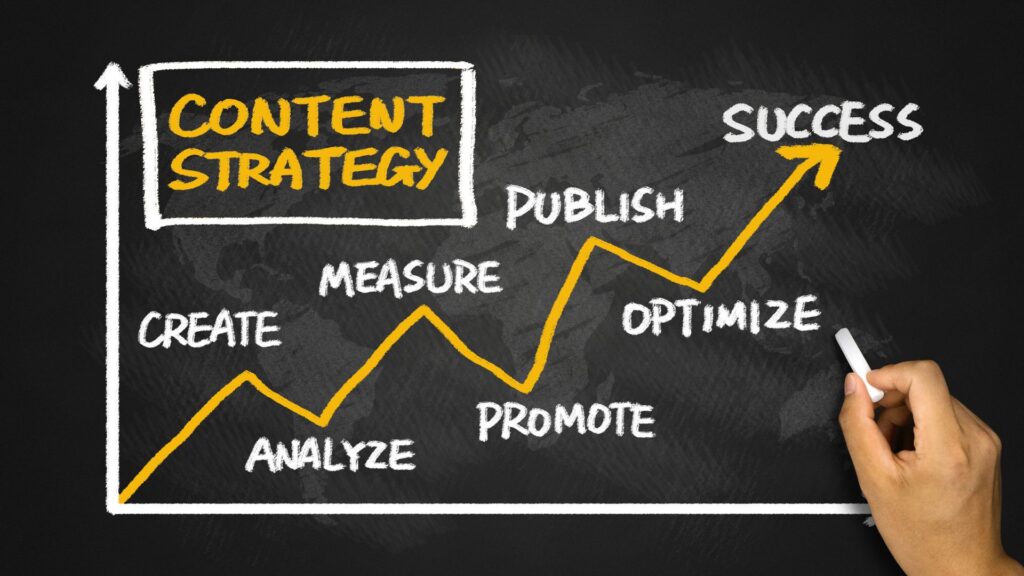In today’s digital age, content is more than just king—it’s the lifeblood of successful marketing strategies. High-quality content is the driving force behind increased engagement, improved SEO rankings, and higher conversion rates. According to a study by HubSpot, businesses that prioritize blogging are 13 times more likely to see a positive ROI compared to those that do not. This underscores the critical role that high-quality content plays in digital marketing.
Creating content that stands out in a crowded online space requires more than just good writing. It demands a strategic approach that combines deep audience understanding, meticulous planning, and the use of the right tools. This guide will equip you with the knowledge and techniques needed to craft compelling content that not only captures your audience’s attention but also drives meaningful results.
We’ll explore what makes content high-quality, from originality and relevance to depth and engagement. You’ll learn how to conduct effective keyword research and develop a robust content strategy that aligns with your business goals.
We’ll delve into the art of crafting engaging content, incorporating visual elements, and optimizing for SEO. Additionally, we’ll discuss essential tools and resources that can streamline your content creation process and strategies for promoting your content to maximize reach and impact.
Whether you’re a seasoned content marketer or just starting out, this guide offers valuable insights and practical tips to help you create content that not only resonates with your audience but also stands the test of time in an ever-evolving digital landscape. Get ready to transform your content marketing efforts and achieve greater success with high-quality, impactful content.
Understanding High-Quality Content

What Makes Content High-Quality?
High-quality content stands out in the vast ocean of online information. It is crafted to be informative, engaging, and tailored to meet the specific needs of the audience. The essence of high-quality content lies in its ability to provide genuine value, whether through answering questions, solving problems, or offering fresh insights. Here are the key characteristics that define high-quality content:
- Originality: Unique content that offers new perspectives or fresh takes on a subject. This means avoiding rehashed information and instead bringing something novel to the table. Original content helps build authority and credibility.
- Relevance: Content that speaks directly to the interests, needs, and pain points of your target audience. By understanding your audience’s concerns and preferences, you can create content that resonates deeply with them.
- Depth: Comprehensive coverage that explores a topic thoroughly. High-quality content delves into the intricacies of a subject, providing detailed explanations, examples, and insights. This depth of information helps establish trust and authority.
- Engagement: Interactive elements that encourage reader interaction. This can include questions, calls to action, multimedia elements, and opportunities for readers to share their thoughts. Engaging content keeps readers interested and encourages them to return.
High-quality content builds trust with your audience. When readers find your content valuable, they are more likely to share it, bookmark it, and return for more. This ongoing engagement not only enhances your content’s reach but also strengthens your brand’s reputation.
The Role of High-Quality Content in Digital Marketing
Quality content is the cornerstone of effective digital marketing. It enhances your online presence, improves SEO rankings, and drives user engagement. Businesses that invest in high-quality content see higher traffic and better conversion rates. For instance, a blog post that answers common customer questions not only drives traffic but also positions your brand as a trusted authority. This trust translates into higher customer loyalty and increased sales.
- Enhances Online Presence: Consistently producing high-quality content increases your visibility online. It ensures that your website remains active and up-to-date, which is favorable for search engines and attracts regular visitors.
- Improves SEO Rankings: Search engines prioritize high-quality content that is well-structured, relevant, and valuable to users. By incorporating SEO best practices, such as using relevant keywords, optimizing meta tags, and ensuring mobile-friendliness, high-quality content can significantly boost your search engine rankings.
- Drives User Engagement: Engaging content captivates readers, encouraging them to spend more time on your site, interact with your content, and share it with others. This increased engagement signals to search engines that your content is valuable, further improving your SEO rankings.
- Builds Authority and Trust: High-quality content positions your brand as a thought leader in your industry. By providing valuable insights and reliable information, you build trust with your audience, which can lead to higher customer loyalty and increased sales.
For instance, a blog post that answers common customer questions not only drives traffic but also positions your brand as a trusted authority. This trust translates into higher customer loyalty and increased sales.
Businesses that invest in high-quality content see higher traffic and better conversion rates, making it an essential component of any digital marketing strategy.
Research and Planning

Know Your Audience
Understanding your audience is the foundation of effective content creation. To create content that resonates, you must know who your audience is, what they care about, and how they behave online.
Here’s how to gather this crucial information:
- Demographic Analysis: Start by looking at basic demographic data such as age, gender, location, and occupation. Tools like Google Analytics can provide this information, helping you to segment your audience and tailor content to different groups.
- Behavioral Insights: Understanding your audience’s online behavior and content preferences is vital. Analyze data on how they interact with your content, what types of content they prefer, and what channels they use to engage with your brand. Social media insights and website analytics can offer valuable information on user behavior.
- Psychographics: Go beyond demographics and behavior to understand your audience’s interests, values, and lifestyle choices. This deeper understanding helps you create content that not only attracts but also deeply resonates with your audience. Surveys, polls, and direct feedback can provide rich psychographic data.
Creating detailed buyer personas based on these insights can help you tailor your content strategy to meet the specific needs and preferences of your audience. These personas should include information such as demographic details, interests, pain points, and content consumption habits.
Conducting Keyword Research
Effective keyword research is vital for reaching your target audience and improving your content’s visibility in search engine results.
Here’s how to conduct thorough keyword research:
- Identify Seed Keywords: Start with broad terms related to your industry. These are the foundational keywords that you will expand upon through your research.
- Analyze Competitors: Check what keywords your competitors are ranking for. Tools like Ahrefs and SEMrush can provide insights into the keywords that drive traffic to competitor sites. Understanding these keywords can help you identify opportunities to compete.
- Use Keyword Tools: Utilize tools like Google Keyword Planner, Ubersuggest, SEMrush, and others to generate keyword ideas. Look for long-tail keywords that are more specific and often have less competition. These keywords can help you attract a more targeted audience.
- Assess Keyword Metrics: Evaluate the search volume, competition, and relevance of potential keywords. Aim for a mix of high-volume, competitive keywords and lower-volume, less competitive ones to balance your SEO strategy.
Effective keyword research ensures your content reaches the right audience by addressing their specific queries and needs. It also helps in optimizing your content to rank higher in search engine results, driving organic traffic to your site.
Developing a Content Strategy
A robust content strategy ensures consistency and effectiveness in your content marketing efforts. It involves planning, creating, and managing content that aligns with your business goals and meets the needs of your audience.
Here’s how to develop a comprehensive content strategy:
- Content Calendar: Schedule and plan your content publication. A content calendar helps you stay organized, ensuring that you produce and publish content regularly. It also allows you to plan content around key dates and events relevant to your industry.
- Content Types: Diversify your content with articles, videos, infographics, and podcasts. Different types of content appeal to different segments of your audience and can be used to achieve various marketing goals. For example, blog posts are great for detailed explanations, while videos are effective for demonstrating products.
- Goals and KPIs: Define what success looks like for your content marketing efforts and how you will measure it. Key performance indicators (KPIs) might include metrics such as page views, engagement rates, lead generation, and conversion rates. Setting clear goals and KPIs allows you to measure the effectiveness of your content strategy and make data-driven decisions.
By understanding your audience, conducting thorough keyword research, and developing a well-rounded content strategy, you can create high-quality content that resonates with your audience, drives engagement, and achieves your business goals.
Crafting High-Quality Content

Writing Engaging Content
Creating engaging content is about forming a connection with your audience. Start with a compelling introduction that grabs attention. Use a conversational tone to make your content relatable and easy to read.
An engaging piece often begins with an element that hooks the reader right from the start.
Tips for Engaging Writing:
- Strong Hook: Begin with a question, a bold statement, or an interesting fact to draw readers in. For example, “Did you know that 70% of consumers prefer learning about products through content rather than traditional advertisements?”
- Clear Structure: Use headings, subheadings, and bullet points to organize content, making it easier for readers to skim and find the information they need.
- Concise Language: Avoid jargon and write in clear, straightforward language. Aim for simplicity and clarity to ensure your message is understood.
Incorporating storytelling into your content can also create emotional connections with your audience. For example, share a success story of how your product helped a customer solve a problem. Storytelling not only makes your content more engaging but also more memorable.
Incorporating Visual Elements
Visuals such as images, infographics, and videos can significantly enhance the appeal and effectiveness of your content. They help break up text, making your content more digestible and visually appealing.
Moreover, visual elements can improve SEO by increasing the time visitors spend on your page and reducing bounce rates.
Benefits of Visual Elements:
- Enhanced Understanding: Visuals can explain complex ideas more clearly, making it easier for readers to grasp key points.
- Increased Engagement: Images and videos attract attention and keep readers engaged. According to research, articles with images get 94% more views than those without.
- Better Retention: People remember information better when it’s paired with visuals. Infographics, for instance, can increase recall rates due to their combination of text and imagery.
SEO Best Practices
Optimizing your content for search engines is crucial for improving visibility and driving traffic. This involves using primary keywords naturally throughout the text, in meta tags, and in headings. Ensure your site is mobile-friendly and loads quickly, as these factors also affect SEO rankings.
Key SEO Techniques:
- Meta Tags: Include title tags and meta descriptions with keywords. A well-crafted meta description can significantly improve click-through rates from search engine results pages.
- Header Tags: Use H1, H2, and H3 tags to structure your content. Proper use of headers not only improves readability but also helps search engines understand the hierarchy and main topics of your content.
- Alt Text: Describe images accurately for accessibility and SEO. This helps search engines index your images properly and can improve your visibility in image search results.
- Internal Links: Link to other relevant content on your site. This helps keep visitors on your site longer and improves the overall SEO health of your site by establishing a clear site structure.
Tools and Resources
Essential Content Creation Tools
Utilizing the right tools can significantly enhance your content creation process, making it more efficient and ensuring higher quality output.
Here are some recommended tools that every content marketer should consider:
- Grammarly: This tool is essential for checking grammar and spelling. It not only corrects basic errors but also suggests improvements for clarity and tone. Grammarly’s real-time feedback helps you maintain a professional standard in your writing.
- Hemingway Editor: Hemingway Editor is designed to enhance readability. It highlights complex sentences, passive voice, and adverb overuse, making your content clearer and more concise. By improving readability, you make your content more accessible to a broader audience.
- Canva: Visual content is crucial for engaging readers, and Canva is a powerful tool for creating high-quality visuals and graphics. With its easy-to-use interface and vast library of templates, you can design eye-catching images, infographics, and social media posts without needing advanced graphic design skills.
- Yoast SEO: If you’re using WordPress, Yoast SEO is indispensable for optimizing your content for search engines. It provides real-time analysis of your content, suggesting improvements for keyword usage, readability, and metadata. Yoast SEO helps ensure your content is search-engine friendly and ranks well.
Analytics and Performance Tracking
Monitoring your content’s performance is essential for continuous improvement. Using the right analytics tools, you can track key metrics and gain insights into how your content is performing.
Here are some crucial tools and metrics to consider:
- Google Analytics: This is a comprehensive tool for tracking website traffic and user behavior. It provides detailed insights into page views, time on page, bounce rate, and conversion rates, helping you understand how visitors interact with your content.
- Google Search Console: This tool helps monitor your site’s presence in Google search results. It provides data on search queries, indexing status, and site errors, enabling you to optimize your content and fix issues that may affect your search rankings.
Important Metrics to Monitor:
- Page Views: This metric shows how often your content has been viewed, indicating its popularity and reach.
- Time on Page: The average duration users spend on your content. Longer times typically suggest higher engagement.
- Bounce Rate: The percentage of visitors who leave after viewing only one page. A high bounce rate may indicate that your content isn’t engaging or relevant.
- Conversion Rate: The percentage of visitors who take a desired action, such as subscribing to a newsletter or making a purchase. This metric is crucial for measuring the effectiveness of your content in driving business goals.
Promoting Your Content

Maximizing Reach Through Social Media
Promoting your content on social media is essential for reaching a broader audience. Tailoring your posts to each platform’s unique audience and style can significantly boost engagement.
Strategies for Social Media Promotion:
- Platform Selection: Choose platforms where your audience is most active. For instance, LinkedIn is ideal for B2B content, while Instagram is better for visually-driven content.
- Engaging Posts: Use eye-catching images and compelling headlines to draw attention. Share snippets of your content to entice readers to click through.
- Regular Interaction: Engage with your followers by responding to comments and messages. Encouraging discussions and participating in conversations can build relationships and increase your content’s visibility.
Email Marketing
Email remains a powerful tool for content distribution. Building a subscriber list and sending regular newsletters featuring your latest content can drive traffic and engagement. Personalizing your emails can further enhance their effectiveness.
Email Marketing Tips:
- Segmentation: Group your audience based on interests and behaviors to send more targeted emails.
- Personalization: Use the recipient’s name and tailor content to their preferences to make your emails more engaging.
- Clear CTA: Include a clear call-to-action in each email to encourage readers to take the desired action.
Leveraging Influencer Partnerships
Collaborating with influencers in your industry can significantly expand your content’s reach. Influencers can help you tap into new audiences and add credibility to your content.
To Maximize Influencer Partnerships:
- Identify Relevant Influencers: Choose influencers whose audience aligns with your target market. Use tools like BuzzSumo or Upfluence to find suitable influencers.
- Build Relationships: Engage with influencers by commenting on their posts and sharing their content. Building a relationship before proposing a partnership can increase the chances of collaboration.
- Offer Value: Provide influencers with valuable content or products in exchange for promotion. Ensure the partnership is mutually beneficial.
- Co-Create Content: Work together to create content that benefits both parties and appeals to both audiences. Co-created content often performs better as it combines the strengths and audiences of both collaborators.
By implementing these strategies and using these tools, you can significantly enhance your content creation and promotion efforts, leading to better engagement, higher traffic, and improved SEO performance.
Measuring and Improving Content Quality

Key Performance Metrics
Tracking key performance metrics is essential for assessing your content’s effectiveness. By analyzing these metrics, you can refine your strategy and make data-driven decisions to enhance future content.
Here are the crucial metrics to monitor:
- Engagement Rate: This measures how much users interact with your content, such as likes, comments, shares, and time spent on the page. A high engagement rate indicates that your content resonates well with your audience.
- Conversion Rate: This tracks how well your content drives desired actions, such as signing up for a newsletter, downloading a resource, or making a purchase. A higher conversion rate signifies effective content that leads to tangible outcomes.
- Social Shares: This indicates how often your content is shared on social media platforms. High social share numbers suggest that your content is valuable and share-worthy, expanding your reach organically.
Conducting Content Audits
Regularly auditing your content is vital to identify what’s working and what’s not. Content audits help you update outdated information, improve underperforming pieces, and repurpose high-performing content in new formats.
Here’s a step-by-step guide to conducting a content audit:
- Inventory: Compile a comprehensive list of all your content pieces. This includes blog posts, articles, videos, infographics, and any other content formats you use.
- Analysis: Evaluate the performance of each content piece based on key metrics such as engagement rate, conversion rate, and social shares. Identify which pieces are performing well and which are not meeting expectations.
- Action: Based on your analysis, decide which content pieces to update, delete, or repurpose. For example, a well-performing blog post can be turned into an infographic or a video, and underperforming content can be updated with new information or optimized for SEO.
Continuous Improvement
Content creation is an ongoing process. To maintain relevance and effectiveness, it’s crucial to continuously seek feedback, stay updated on industry trends, and refine your strategy.
Here are some tips for continuous improvement:
- Audience Feedback: Use surveys, polls, and comments to gather insights directly from your audience. Understanding their preferences and pain points helps tailor your content to meet their needs.
- Stay Updated: Follow industry news, attend webinars, and read reports to stay informed about the latest trends and best practices in content marketing. Adapting to changes in the industry ensures your content remains relevant and effective.
- Experiment: Don’t be afraid to try new content formats, styles, and strategies. A/B testing different approaches can provide valuable insights into what works best for your audience. For example, experiment with different types of headlines, multimedia elements, and calls to action.
Summary
Creating high-quality content is both an art and a science. By understanding your audience, leveraging the right tools, and following best practices, you can produce content that not only captures attention but also drives meaningful results. Start implementing these strategies today, and watch your content rise in search rankings and resonate with your audience.
Remember, the journey of content creation is ongoing. Continuously analyze, adapt, and improve to stay ahead in the ever-evolving digital landscape. With dedication and strategic planning, your content will not only attract but also retain a loyal audience, driving sustained success for your brand.


